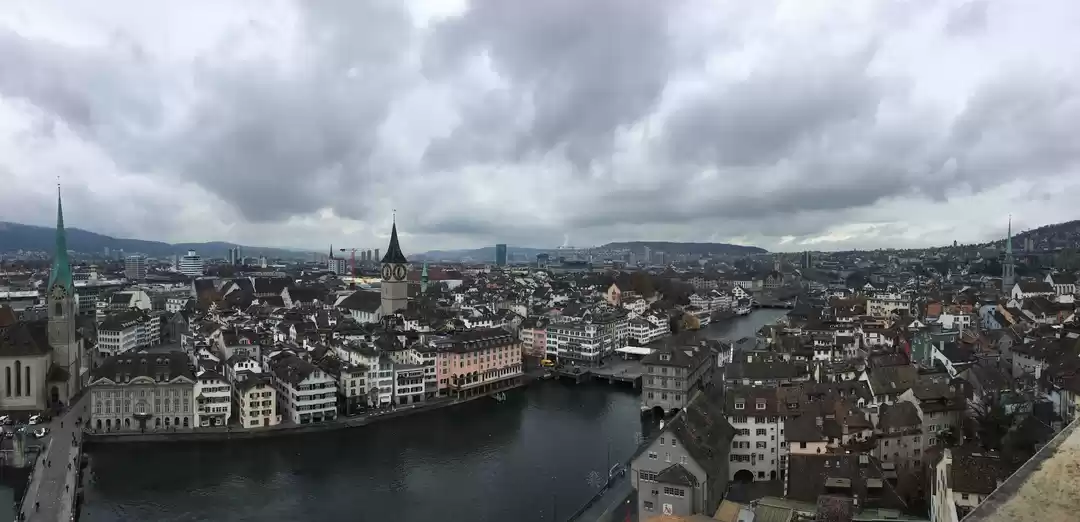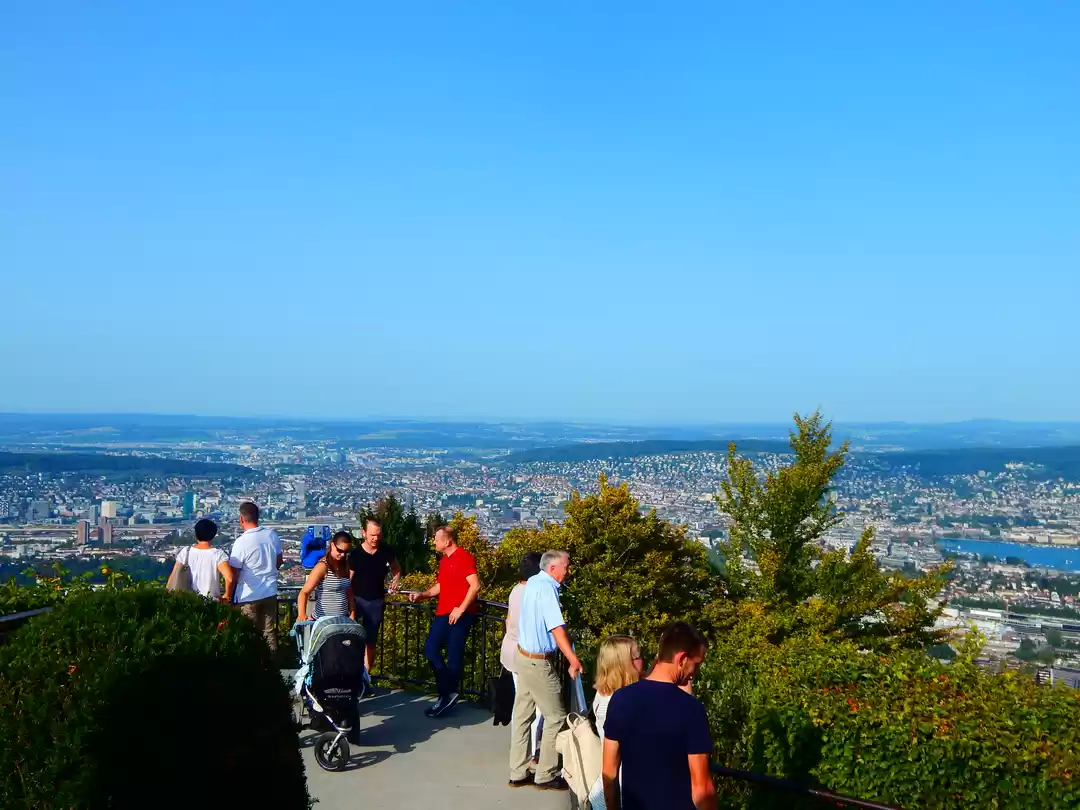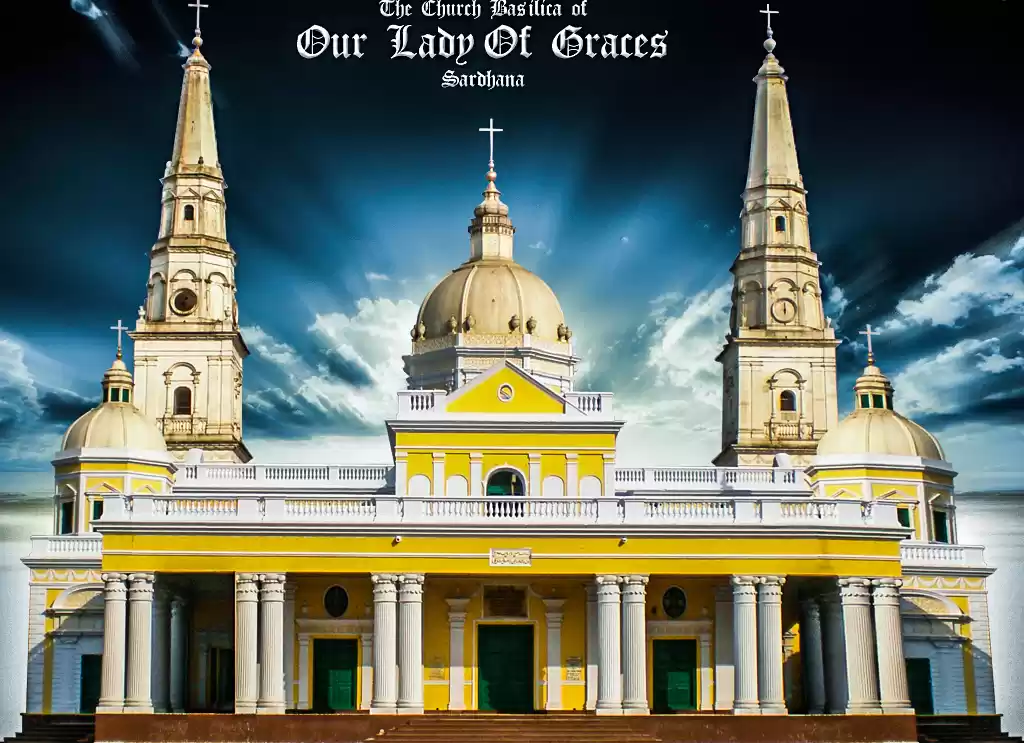Zurich is a city that combines the charm of the old and the new, the natural and the urban, the traditional and the modern. It is a city that offers something for everyone, whether you are interested in culture, history, art, or nature. But among the many attractions and sights that Zurich has to offer, there is one that stands out as a must-see for any visitor: the Fraumunster Church.
The Fraumunster Church is one of the four major churches in Zurich, along with the Grossmunster, the St. Peter's Church, and the Predigerkirche. It is located on the west bank of the Limmat River, opposite the Grossmunster, and it is easily recognizable by its slender blue-green spire that rises above the city skyline. The Fraumunster Church is not only a beautiful and impressive building, but also a rich and fascinating repository of history, architecture, and art. It is a place where you can admire the stunning stained glass windows by Marc Chagall, one of the most renowned and influential artists of the 20th century, as well as other artworks by Augusto Giacometti and Paul Bodmer. It is also a place where you can learn about the origin and significance of the church and its convent, which dates back to the 9th century and played a crucial role in the development and reformation of Zurich.

History of Fraumunster Church
The Fraumunster Church has a long and illustrious history that spans over a thousand years. It was founded in 853 by King Louis the German, the grandson of Charlemagne, as a convent for aristocratic women. The convent was endowed with many privileges and rights, such as the minting of coins, the collection of tolls, and the immunity from the jurisdiction of the city. The convent was also granted the patronage of many lands and churches in Switzerland and Germany, making it one of the most powerful and influential institutions in the region.
The abbesses of the convent were often members of the royal or noble families, and they had a close relationship with the kings and emperors who supported and protected the convent. One of the most famous and influential abbesses was Hildegard, who ruled from 853 to 906. She was the daughter of Louis the German and the sister of Emperor Charles the Fat. She was also a friend and correspondent of Einhard, the biographer of Charlemagne. Hildegard was responsible for expanding and beautifying the convent and the church, and she also promoted learning and culture among the nuns.
The convent and the church witnessed many historical events and changes that affected Zurich and Switzerland. One of the most significant events was the Reformation in the 16th century, which was led by Ulrich Zwingli and Heinrich Bullinger, two of the most prominent reformers in Europe. The Reformation brought about many religious and social reforms, such as the abolition of the mass, the removal of the images and relics, and the dissolution of the monasteries. The convent of Fraumunster was also dissolved in 1524, and the nuns were allowed to leave or to marry. The church became a Protestant parish church, and the convent buildings were used for various purposes, such as a hospital, a school, a prison, and a mint.
The church and the convent also underwent many architectural changes and modifications over the centuries. The original church was built in the Romanesque style, with a nave, a choir, and a crypt. The church was enlarged and renovated in the Gothic and Baroque styles, with the addition of a cloister, a tower, a spire, a portal, and a nave. The church was also damaged by fire, war, and demolition, and it was restored and reconstructed several times. The most radical change occurred in the 19th century, when the convent buildings and the cloister were demolished to make way for the construction of the new city hall and the quay. The church was also rebuilt in the neo-Gothic style, with the exception of the choir, which was preserved in its original Romanesque style.

Architecture of Fraumunster Church
The Fraumunster Church is a remarkable example of the diversity and harmony of architectural styles, from the Romanesque to the neo-Gothic. The church has a simple and elegant exterior, with a slender blue-green spire that rises to a height of 63 meters. The spire was added in 1732, and it is decorated with four clocks and a weather vane. The spire is also topped with a golden ball and a cross, which symbolize the heavenly and the earthly realms.
The main entrance of the church is located on the south side, facing the Limmat River. The entrance is marked by a neo-Gothic portal, which was added in 1898. The portal is adorned with statues of Charlemagne and Louis the German, the founders of the church, as well as the coat of arms of Zurich and Switzerland. The portal also features a tympanum, which depicts the Last Judgment, with Christ as the judge and the angels and the devils as the witnesses.
The interior of the church is divided into two parts: the nave and the choir. The nave is the newer and larger part of the church, which was built in the 19th century in the neo-Gothic style. The nave has a rectangular shape, with a vaulted ceiling and a wooden roof. The nave is illuminated by large windows, which create a bright and spacious atmosphere. The nave also contains the organ, which was installed in 1956. The organ has four keyboards, 92 registers, and 5,793 pipes, and it is considered one of the finest organs in Switzerland.
The choir is the older and smaller part of the church, which was built in the 13th century in the Romanesque style. The choir has a semi-circular shape, with a vaulted ceiling and a stone roof. The choir is decorated with frescos, which were painted by Paul Bodmer in 1970. The frescos depict scenes from the life of Christ, such as the Annunciation, the Nativity, the Crucifixion, and the Resurrection. The choir also contains the crypt, which is the oldest part of the church, dating back to the 9th century. The crypt is a small and dark chamber, which houses the tombs of some of the abbesses and the kings who supported the church.

Art of Fraumunster Church
The Fraumunster Church is not only a place of worship and history, but also a place of art and beauty. The church is home to some of the most exquisite and unique artworks in Zurich, especially the stained glass windows by Marc Chagall and Augusto Giacometti. The stained glass windows are the main attraction and the highlight of the church, and they are a must-see for any art lover.
Marc Chagall was one of the most renowned and influential artists of the 20th century, who was born in Belarus and lived in France, Russia, and the United States. He was known for his colorful and expressive paintings, which combined elements of Cubism, Expressionism, Surrealism, and Fauvism. He was also a master of stained glass, which he used to create luminous and poetic compositions that reflected his spiritual and artistic vision.
Chagall created five stained glass windows for the Fraumunster Church, which were installed in 1970. The windows are located in the choir, and they cover the entire east wall of the church. The windows depict scenes from the Old and the New Testaments, such as the Creation, the Fall, the Redemption, the Prophets, and the Law. The windows are composed of vibrant and contrasting colors, such as blue, red, green, yellow, and purple, which create a stunning and dramatic effect. The windows also feature various symbols and motifs, such as animals, flowers, stars, angels, and musical instruments, which represent the themes and messages of the biblical stories.

Augusto Giacometti was another famous and influential artist of the 20th century, who was born and died in Switzerland. He was a cousin of the sculptor Alberto Giacometti, and he was known for his paintings, drawings, and stained glass, which were inspired by nature, art history, and mythology. He was also a pioneer of abstract art, which he used to create geometric and organic forms that expressed his aesthetic and philosophical ideas.
Giacometti created one stained glass window for the Fraumunster Church, which was installed in 1945. The window is located in the south transept, and it covers the entire rose window of the church. The window depicts the Heavenly Jerusalem, which is the symbol of the eternal and perfect city of God. The window is composed of subtle and harmonious colors, such as blue, green, yellow, and white, which create a calm and serene effect. The window also features various shapes and patterns, such as circles, squares, triangles, stars, and flowers, which represent the order and harmony of the heavenly city.
Besides the stained glass windows, the Fraumunster Church also contains other artworks that are worth seeing, such as the frescos by Paul Bodmer and the organ. Paul Bodmer was a Swiss painter and illustrator, who was known for his realistic and detailed paintings of landscapes, portraits, and historical scenes. He painted the frescos in the choir in 1970, which depict scenes from the life of Christ, such as the Annunciation, the Nativity, the Crucifixion, and the Resurrection. The frescos are painted in a classical and naturalistic style, with soft and warm colors, which create a contrast with the modern and abstract style of the windows. The organ is another impressive feature of the church, which was installed in 1956. The organ has four keyboards, 92 registers, and 5,793 pipes, and it is considered one of the finest organs in Switzerland. The organ is used for concerts and recitals, which are held regularly in the church, and which offer a great opportunity to enjoy the music and the acoustics of the church.

Tips and Facts for Visiting Fraumunster Church
If you are planning to visit the Fraumunster Church, here are some practical and useful tips and facts that will help you make the most of your visit:
- The Fraumunster Church is open daily from 10:00 am to 4:00 pm, except on Sundays and public holidays, when it is open from 12:30 pm to 4:00 pm. The admission fee is 5 CHF for adults, and free for children under 16 years old. The admission fee includes an audio guide, which is available in several languages, and which provides more information and insights about the church and its windows.
- The photography and filming of the church and its windows are strictly prohibited, as they are protected by the copyright of the artists and their heirs. Please respect this rule and refrain from taking any pictures or videos inside the church. You can, however, buy postcards and books of the church and its windows at the souvenir shop, which is located at the entrance of the church.
- The best time to visit the church and its windows is in the morning, when the sunlight shines through the windows and creates a magical and colorful effect. The windows are also illuminated by artificial light in the evening, which creates a different but equally beautiful effect. The church is usually less crowded in the morning and in the evening, so you can enjoy the windows and the church in a more peaceful and quiet atmosphere.
- The Fraumunster Church is located in the heart of Zurich, and it is easily accessible by public transport, such as tram, bus, or train. The closest tram and bus stop is Rathaus, which is just a few steps away from the church. The closest train station is Zurich Hauptbahnhof, which is about 15 minutes away by foot or 5 minutes by tram. The church is also within walking distance of many other attractions and sights in Zurich, such as the Grossmunster, the St. Peter's Church, the Limmat River, the Kunsthaus, and the Swiss National Museum.
- The Fraumunster Church is not only a place of history, architecture, and art, but also a place of culture and spirituality. The church hosts various events and activities throughout the year, such as concerts, recitals, exhibitions, lectures, and guided tours. The church also offers services and prayers, which are open to everyone, regardless of their faith or denomination. The church is a place where you can experience the beauty and the diversity of Zurich, as well as the inspiration and the transcendence of the church and its windows.

Conclusion
The Fraumunster Church is one of the most beautiful and iconic landmarks in Zurich, and it is a must-see attraction for any visitor. The church is a place where you can admire the stunning stained glass windows by Marc Chagall and Augusto Giacometti, as well as other artworks by Paul Bodmer and the organ. The church is also a place where you can learn about the history and significance of the church and its convent, which dates back to the 9th century and played a crucial role in the development and reformation of Zurich. The church is also a place where you can enjoy the culture and spirituality of Zurich, as well as the events and activities that the church offers.















